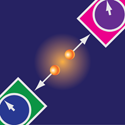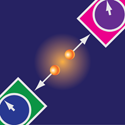Only nonlocals allowed
In quantum mechanics, if two particles are entangled, the results of a measurement on one of the particles depend on the results of a measurement on the other, no matter how far apart they are (though one cannot use these correlations to send signals).
In 1935, Einstein, Podolsky, and Rosen argued that these seemingly nonlocal correlations could mean quantum mechanics was incomplete—a postulate that led to the idea of “hidden variables” that encoded the correlations. But in 1964, J.S. Bell showed that quantum mechanics violates certain inequalities that cannot be violated in a model with only local hidden variables. In order to account for all the predictions of quantum mechanics using hidden variables, including the violation of Bell’s inequalities, one needs a model with nonlocal hidden variables.
Since that time, experiments have verified that Bell’s inequalities are violated just as quantum theory predicts, and hidden variable models have mainly been used as tools to understand the implications of quantum mechanics. Still, one can construct models that have local as well as nonlocal hidden variables [1] and these models have been the subject of recent tests. Now, writing in the current issue of Physical Review Letters, Roger Colbeck and Renato Renner from the ETH in Zurich show that any model that explains two-particle correlations with a mixture of local and nonlocal hidden variables fails to match quantum predictions for a chained set of Bell inequalities. Bottom line: if you want to mimic quantum mechanics, your model needs to use only nonlocal hidden variables. - Robert Garisto
[1] A. J. Leggett, Found. Phys. 33, 1469 (2003).





